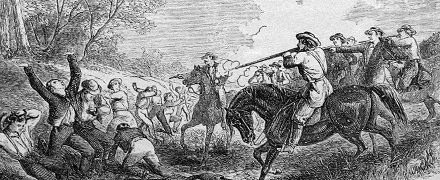Spencer Kellogg Brown, a young Union spy during the U.S. Civil War, was hanged on this date in 1863 in the rebel capital of Richmond, Virginia.
Brown would come by the latter years of his short life to commonly drop his surname and simply go by Spencer Kellogg: this was fruit of the same cause for his enthusiasm for the northern cause, to wit, his growing to manhood in Osawatomie, the antislavery epicenter of the dirty frontier war known as “Bleeding Kansas”. But the thing about the name was, notwithstanding Kellogg’s/Brown’s enthusiasm for the Free State side, the surname he chanced to share with the ferocious abolitionist warrior John Brown was liable to get a body killed when uttered in the wrong company. (There was no blood relationship between Spencer Brown and John Brown.)
Spencer Kellogg Brown was just a teenager when he joined the Union army but the pell-mell ramp-up to war footing opened opportunities for able people. Brown rose out of the enlisted ranks to an officer’s commission and was detailed for risky scouting assignments into rebel territory down the Mississippi River, even feigning desertion so that he could enlist in the Confederate ranks and then escape back to his own lines with intelligence. Execution was an occupational hazard of this daring profession; eventually, young Brown was captured one too many times.
This public domain volume summarizes the man’s short biography, including many affectionate letters that Brown exchanged with family in the course of his adventures and his subsequent year-long imprisonment. If you like, you can imagine them in that Ken Burns documentary portentous voice-over reading.
Castle Thunder, Richmond, Virginia, Sept. 18, 1863.
Dear Kitty, my Sister: After lying in prison over a year, my time has come at last. To-day I went out for trial, but got it deferred until to-morrow. The witnesses are there, and there can be but one result, death. So I have written to you for all, to bid you a last good-bye, God bless you, I have tried to write often to cheer all, and it seemed very hopeful for a while, but within a few days all hope has left me. But don’t mourn, Kitty, as for one without hope. These only take away the mortal life, but God, I trust, has given me one that is immortal. Dear Kitty, I hope there is a ‘shining shore’ for us all, and another world where, free from guilt, we’ll no more sorrow, or part. I do not look forward with fear to death — not nearly as much as when it was farther off. God has been very kind to me, and for the past twelve months I have tried earnestly to please Him. I fear the embarrassment of the trial, to-morrow, the worst, but He will help me, I trust.
I have some little trinkets; you must divide them. The ring is for my wife; if she be not found, for yourself. Take comfort now, dear ones, God is good, and naught shall separate us from Him. I have hoped and longed, indeed, to see you all; but I know His wisdom chooses better; let us be content. Thank Him that all this time He has given me life and health and a heart to love Him, and to trust in Christ. Much as I long to see you all, I know ’tis best as it is, for He doeth all things well. So do not mourn, but hope — and think of heaven, where I hope, by God’s mercy, to await you all.
On this day..
- 1965: The Carrillos, by the ELN
- 1852: The assassin of Korfiotaki
- 1714: Geczy Julianna, the White Woman of Locse
- 1987: Gennady Modestovich Mikhasevich, Belarus serial killer
- 1794: Edmund Fortis, in the hands of God
- 1911: Dmitry Bogrov, Stolypin's assassin
- 2013: Xia Junfeng, chengguan slayer
- 1561: Sehzade Beyazit, inevitably
- 1991: Warren McCleskey
- 1998: Cao Haixin, unwelcome meddler
- 2007: Michael Richard, whose time ran out
- 1792: Jacques Cazotte, occultist

